HABEY BIS-6922 Fanless Ivy Bridge Industrial PC Review
by Ganesh T S on August 13, 2013 9:00 AM EST- Posted in
- Industrial PC
- Ivy Bridge
- Passive Cooling
- Habey
Power Consumption and Thermal Performance
The power consumption at the wall was measured with the display being driven through the HDMI port. In the graphs below, we compare the idle and load power of the BIS-6922 with other low power desktop / industrial PCs. For load power consumption, we ran Furmark 1.11.0 and Prime95 v27.9 together.
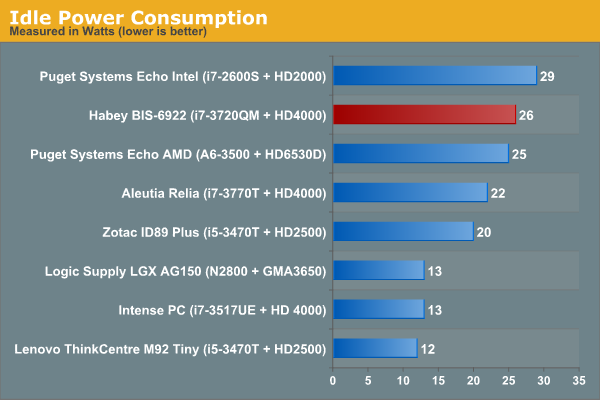
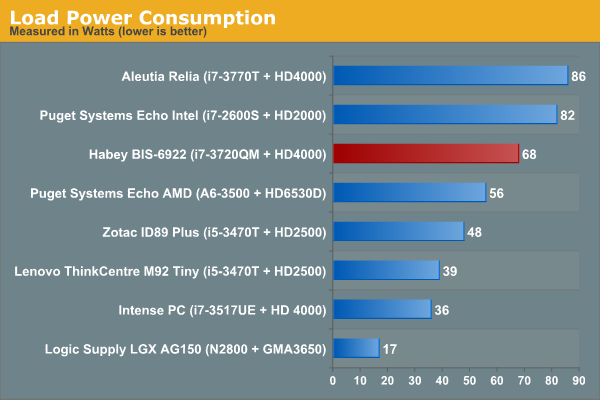
One of the unfortunate aspects of the Aleutia Relia was that the unit ended up getting throttled when subject to heavy loading even at room temperature (72 F). It is definitely challenging to cool 45W TDP processors in a mini-ITX sized chassis, and Aleutia had to get back to the drawing board after our findings were published. After that exercise, I was looking forward to evaluating other fanless PCs in order to gauge their thermal performance under heavy loading. Our custom fanless Ivy Bridge HTPC managed to do quite well, but it was in a ATX-sized chassis.
Habey is not new to the fanless game, and their experience shows in the choice of processor for the BIS-6922 review sample. While the i7-3770T used in the Aleutia Relia and the i7-3720QM used in the BIS-6922 both have a 45W TDP, we find that the former's TCASE is 70C (TJUNCTION around 75C) and the latter has a TJUNCTION of 105C. This gives the cooling system more leeway to operate without throttling the processor.
We conducted thermal testing by fully loading up both the CPU and the GPU for 18 hours. The room temperature varied between 74 F and 78 F during the duration of the test. Power consumption at the wall was recorded for the first 90 minutes or so (and we found that it settled down to around 67 W beyond that). Unlike the Aleutia Relia where thermal throttling was activated and resulted in power consumption at the wall going down after some time, we find that there is no thermal throttling at play in this system. The load and CPU frequencies were presented in the Relia review, but we won't present them here since the load stayed at 100% and the frequency of the cores was always at 2.594 GHz throughout the course of the stress test.
The average of the temperatures of the four cores of the CPU is presented in the graph above. The maximum junction temperature of the Core i7-3720QM is 105 C, and the BIS-6922 cooling mechanism was able to keep it under that without throttling the CPU. We find that it did touch 105 C once, but the temperature was gradually pulled down without throttling the clocks. On one hand, this makes us a bit worried about the possibility of throttling when the ambient temperature exceeds 80F or so. On the other hand, the above experiment was conducted with the unit placed on the floor in a closed room without any forced air flow. At higher surrounding temperatures, it is definitely advisable to ensure some sort of air flow over and around the unit to help with the cooling process. Habey indicated that the unit could be operated even with the ambient at 50 C, though we suppose they don't expect their customers to run artificial CPU and GPU loading programs to stress the system for days together.
Another interesting aspect is how fast the unit is able to get back to the idle temperature after removal of the processor load. The graph below shows that the unit gets back to the 45C (within 10C of the idling temperature) within 60 minutes.
We conclude this section with a thermal profile of the case after 18 hours of being subject to full CPU and GPU loading. Temperatures are noted in the format (F / C).


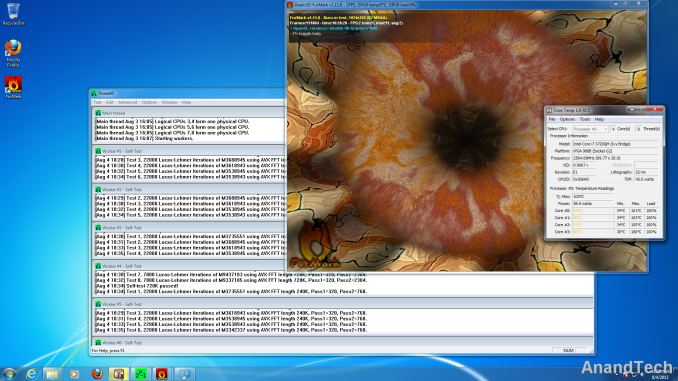
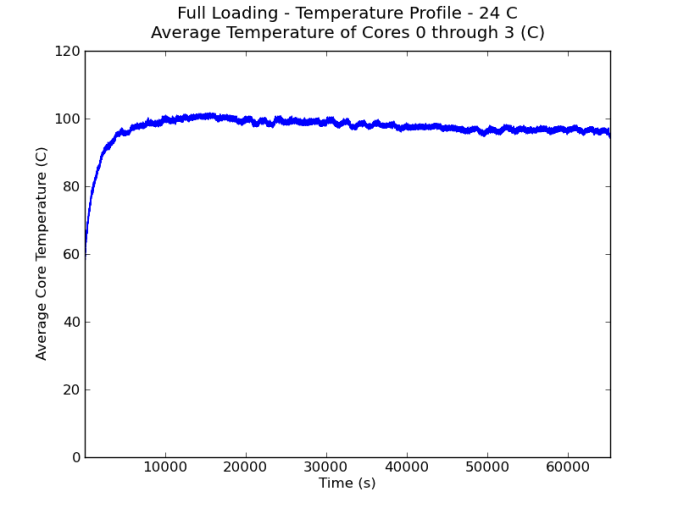
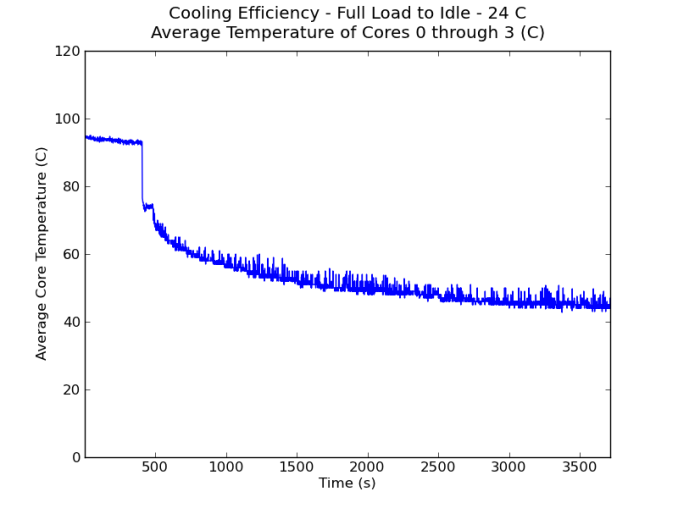
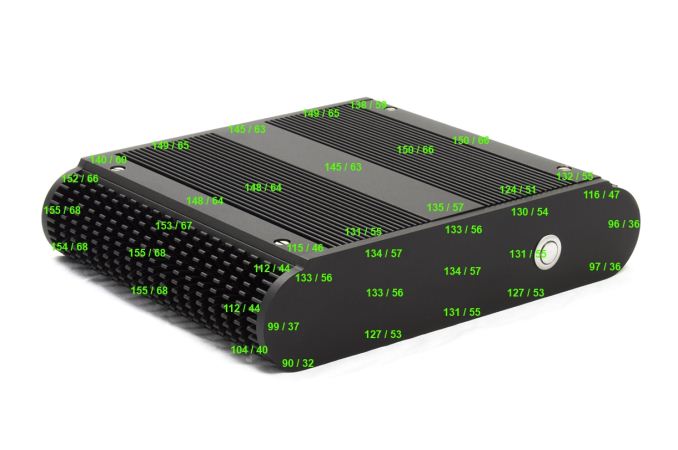
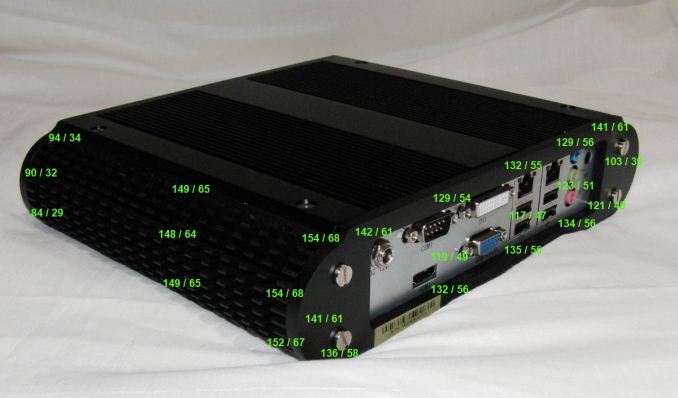








63 Comments
View All Comments
prophet001 - Tuesday, August 13, 2013 - link
Something that will behind installed in other machines and used industrially should be tested at temperatures more extreme than 74 to 78 degrees Fahrenheit.azjeep - Tuesday, August 13, 2013 - link
Agreed...I am in Tucson, Arizona. This would be great for our shipping clerk but he works indoor but with a large rollup door right next to his office. In the summer his office easily exceeds 90 degrees.Lord 666 - Tuesday, August 13, 2013 - link
Is your business a sweat shop?Samus - Tuesday, August 13, 2013 - link
Exactly, this will be inside a kiosk. And considering how fast it cools off, by the time it is powered off and removed from the kiosk it'll be stable enough to manage. That's the remarkable part.ganeshts - Tuesday, August 13, 2013 - link
That is an artificial test case meant to determine how hot the case would become. I hardly expect average consumers to fully load both CPU and GPU 24x7.By the way, what other fanless mITX configuration is there with such a powerful CPU?
UpSpin - Tuesday, August 13, 2013 - link
Why should you buy such a powerful CPU if you won't use it. I can imagine, that maybe some movie/music editor would like a fanless dead silent system. Whenever he renders the scene, all four cores will get loaded. The GPU is just a IGP, which won't add that much to the overall temperature. So it's just too hot!You also have to keep in mind that inside it will be equivalently hot, causing a reduce life of the used parts.
The design is just poor. They would have needed something like the new Mac Pro, which, in my opinion, is the best design for a passive system, because it works like a chimney and causes air flow both inside and out.
Dentons - Tuesday, August 13, 2013 - link
Agreed. What's the point of having an i7 if it can't be used without subjecting the user to burn hazards and sending the components to an early death? If the outside of the case reaches 155 F, how hot does the RAM get? The SSD? The interior heat was probably well above the recommended tolerance of those and other components.It's not like there aren't use cases for quiet, dust resistant, but powerful machines. A video producer could certainly use a perfectly quiet machine and would definitely run the CPU at full throttle for hours on end. A site architect or movie crew might also find such a combination more beneficial than an i7 laptop.
Most industrial users would probably find a Celeron, Pentium, or i3 more than adequate. This may be a fine case with those lesser chips, but since it wasn't tested, we just don't know. The i7 clearly seems a bit much for their product. They should probably have delivered a more typical customer build for testing, instead of trying to push the envelope with Intel's latest, greatest.
airmantharp - Tuesday, August 13, 2013 - link
Actually, Haswell seems more suited for this product- but Ivy is cheap (for now). The system can hold it's own without external help, and provides the perfect balance of performance for it's size and passive cooling. With even a little ventilation, it'd be perfect for running at full load, and few would really stress it that much.Still, I do like the idea of using lesser SKU's; but that's not what this design is for.
xrror - Wednesday, August 14, 2013 - link
7th sentence into the article. "So, it is not surprising that Ivy Bridge-based industrial computers are seeing a strong presence in the market only now after long-term validation by the manufacturers."?
jabber - Wednesday, August 14, 2013 - link
In reality how many people really need a i7 full stop?